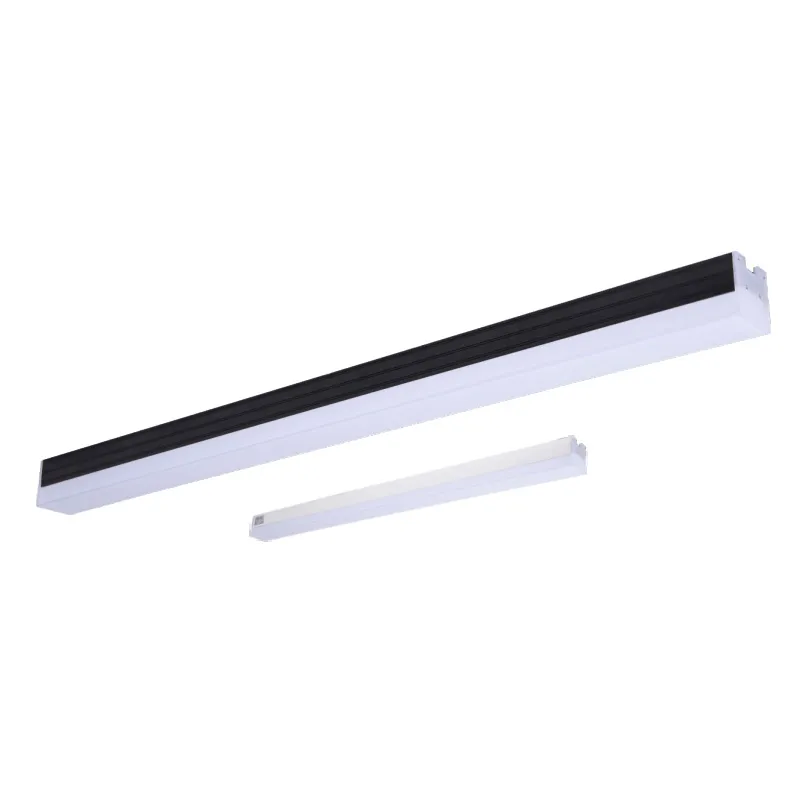What are the different types of linear lighting?
2024-10-15
Linear lighting refers to lighting fixtures that are long and narrow, providing a continuous light source along their length. They are commonly used for both functional and decorative purposes in a variety of settings. Here are the different types of linear lighting:
- Description: This type uses LED technology, known for its energy efficiency, long lifespan, and flexibility in design.
- Applications: LED linear lights are used in commercial spaces, offices, residential areas, and retail environments. They offer consistent, bright illumination and are available in various color temperatures and brightness levels.
- Advantages: Energy-efficient, long-lasting, low heat output, and available in flexible and rigid forms.

2. Recessed Linear Lighting
- Description: Installed flush with the ceiling, wall, or floor, recessed linear lighting fixtures are hidden within the surface, providing a clean and minimalist look.
- Applications: Common in modern offices, kitchens, hallways, and architectural lighting to highlight specific features. It provides ambient or accent lighting without visible fixtures.
- Advantages: Sleek, integrated appearance, ideal for creating a modern aesthetic.
3. Surface-Mounted Linear Lighting
- Description: These fixtures are mounted directly on the surface of ceilings or walls.
- Applications: Often used in spaces where recessed lighting isn't possible, such as in concrete or wooden ceilings. They can be found in offices, retail spaces, and residential areas.
- Advantages: Easy to install, versatile, and available in various sizes and designs.
4. Suspended Linear Lighting
- Description: Linear lighting fixtures that hang from the ceiling using suspension cables. This type of lighting is often used for both ambient and task lighting.
- Applications: Ideal for offices, conference rooms, retail spaces, and dining areas. Suspended lights can be installed above tables, kitchen islands, or workspaces.
- Advantages: Provides an elegant look, adjustable height, and can be used to direct light over specific areas.
5. Track Linear Lighting
- Description: Linear lighting that is mounted on tracks, allowing for adjustable fixture placement along the track. It can be customized by moving or changing the direction of light fixtures.
- Applications: Often used in art galleries, retail stores, or spaces that require flexible and adjustable lighting options.
- Advantages: Highly customizable, allows for directional lighting, and is easy to reconfigure.
6. Continuous Row Linear Lighting
- Description: This lighting involves multiple linear fixtures connected end-to-end to create a continuous strip of light.
- Applications: Suitable for large spaces such as offices, industrial warehouses, or commercial spaces that require uniform lighting over long distances.
- Advantages: Provides consistent, uninterrupted light, perfect for long corridors, hallways, or open spaces.
7. Flexible LED Strips
- Description: Flexible, adhesive-backed LED strips that can be shaped and installed on various surfaces. They are typically low-voltage and can be cut to fit specific lengths.
- Applications: Used for accent lighting, under-cabinet lighting, or highlighting architectural features like stairs, shelves, or coves. They are common in both residential and commercial settings.
- Advantages: Highly versatile, can be installed in tight spaces or around curves, and easy to install with adhesive backing.
8. Corner or Cove Linear Lighting
- Description: Installed in corners, coves, or recessed areas, this lighting creates indirect illumination by reflecting light off surfaces such as ceilings or walls.
- Applications: Commonly used for ambient lighting in living rooms, kitchens, hotels, and restaurants, as well as for creating an elegant atmosphere by highlighting architectural details.
- Advantages: Soft, indirect lighting that enhances ambiance without glare.
9. Waterproof Linear Lighting
- Description: Designed to withstand moisture, these linear lights are often sealed with silicone or other waterproof materials.
- Applications: Used in bathrooms, outdoor settings, swimming pools, or areas where water exposure is a concern.
- Advantages: Waterproof and dustproof, suitable for harsh environments or outdoor use.
10. RGB Linear Lighting
- Description: Linear lights that can change colors using RGB (Red, Green, Blue) LEDs, allowing for dynamic lighting effects.
- Applications: Used in decorative lighting for homes, events, clubs, or entertainment venues. RGB lights can be controlled remotely to adjust colors, brightness, and patterns.
- Advantages: Highly customizable, with color-changing features and dynamic effects for creative lighting designs.
11. Dimmable Linear Lighting
- Description: Linear lights with dimming capabilities that allow you to adjust the light output based on the task or ambiance desired.
- Applications: Common in residential settings, offices, and hospitality environments where the ability to control lighting levels is important.
- Advantages: Energy-saving, creates a mood-specific ambiance, and enhances comfort with adjustable brightness.
Summary:
Linear lighting comes in various forms, from energy-efficient LEDs to customizable track lighting and decorative RGB options. Whether recessed, surface-mounted, or suspended, each type serves different needs, including functional task lighting or aesthetic accent lighting. Depending on the application, you can choose lighting that enhances architectural details, provides uniform illumination, or creates specific moods.

